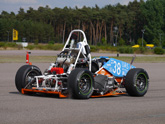
HTW Motorsport uses Stratasys 3D printing technology to produce 3D printed parts for Formula type race cars like the BRC2014
Team enjoys comparative increase in horsepower of around 10% versus traditional manufacturing methods- "3D printing of complex parts is fastest and preferred way of manufacturing airbox", says team engineer
Stratasys Ltd. (Nasdaq:SSYS), a global leader of 3D printing and additive manufacturing solutions, has announced that HTW Motorsport is enjoying improved cost and workflow efficiencies - as well as increased on-track performance - with its Formula-type racecar, by using Stratasys 3D printing technology.
Derived from a student project at the University of Applied Sciences in Berlin, Germany, HTW Motorsport's success follows an ongoing relationship with Stratasys, leveraging a mix of both FDM and PolyJet 3D printing technologies to design and produce engine parts for different cars.
Each year, these cars participate in the global Formula SAE competition, where teams design, build, test and race small-scale formula style cars, which are also judged on their design, fuel economy, acceleration and endurance.
Most recently, taking advantage of Stratasys' Objet500 Connex multi-material 3D Production System, HTW Motorsport used Stratasys' tough high-performance photopolymer Digital ABS material to meet exacting criteria required to 3D print final parts of the airbox (or intake chamber) on its BRC14 race-car.
Patrick Harder, team engineer, HTW Motorsport, says that 3D printing of complex parts is the fastest and preferred way of manufacturing race-ready airboxes. "As a university project, having access to Stratasys' advanced 3D printing technology offers us a massive boost," he says. "It enables us to develop the required parts much faster and incredibly more cost-effectively than we would otherwise be able to."
Adds Harder, "This has delivered proven, quantifiable benefits on the BRC14's airbox system, with a comparative increase in horsepower of around 10% versus the system we used two years before, We also enjoyed an increase in torque of almost 12% over the same timeframe."
3D printed airbox critical to engine performance
"We noted that the use of Stratasys 3D printing technology offers a key advantage in the construction of the BRC14's airbox. A well-designed airbox will draw air more efficiently and effectively into the engine and thus improve performance," explains Harder. "The role of 3D printing is fundamental, as it allows us to create a functional prototype which then becomes part of the final race vehicle."
The attributes of Stratasys Digital ABS make it the material of choice for HTW when it comes to meeting the airbox design and performance requirements, head-on. "High temperature resistance and fuel resistance are vital prerequisites for the airbox, so Digital ABS is perfect," he adds. "This, and its high strength-to-weight ratio, make it the best material for the airbox's plenum chamber which requires a combination of toughness, unique geometry and high surface finish."
On track to further reduce weight
HTW Motorsport is currently designing its next car which will launch in June and compete in this year's race season. Once again, the team is incorporating 3D printed end-use race-ready parts into its construction, with the overall objective to further improve on-track performances by reducing the car's weight.
"With the help of Stratasys 3D printed parts, we are aiming to reduce the weight of our next car by around 45Kg," says Harder. "This will see us incorporate a fully-3D printed steering wheel and fuel tank, as well as a slightly smaller 3D printed airbox. We'll also be constructing a number of boxes that house the many micro-controllers on the car and expect 3D printing to deliver almost 80% weight reduction compared to using standard options from electronic suppliers."
HTW Motorsport's BRC14 race car and engineers will be one of the main attractions at the 3D Printshow Berlin, which takes place from 26th - 28th March at the city's Station Berlin exhibition center.
www.stratasys.com

































































































